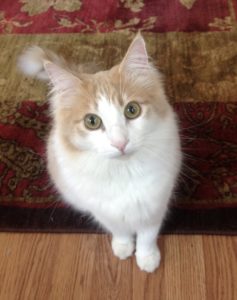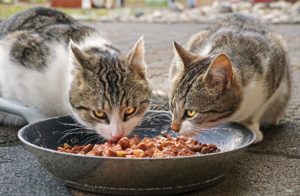Are Toxic Preservatives Hiding In Your Cat’s Food?

Wilbur
Because good sound nutrition is essential to your cat’s health it’s essential you know and understand what your cat is eating. When was the last time you took a look at the list of ingredients on your cat’s food? Does it contain a bunch of words you can’t pronounce or understand? Unless your cat is eating freshly prepared food daily, preservatives must be added to keep it edible for storage purposes. Do you know which preservatives are in your cat’s food and are they safe?
Why use preservatives?
The obvious reason to use preservatives is shelf life. However, how long should we expect something to last and still be considered “safe” to consume? “Best by” and expiration dates are important to note yet commonly overlooked. “Best by” doesn’t mean the food is expired; it simply means it begins to lose nutritional value. In other words, it no longer provides the nutrition stated on the guaranteed analysis. On the other hand, expired food should be thrown away.
Once a product is opened a process called oxidation begins immediately. Oxidation happens when food is exposed to oxygen, and the food starts to chemically alter or break down. Food becomes rancid, toxic and unsafe to consume. Have you ever noticed how your cat may refuse to eat their canned food if it’s been in the refrigerator for more than a day? Even dry food starts to become rancid in as little as 7-14 days once the bag is first opened. Raw food also has its limitations and is best if consumed within 3-4 days of being thawed and refrigerated.
Synthetic vs natural
Preservatives are usually at the very end of the ingredients list. There are both natural and synthetic kinds, and shockingly, some pet foods contain preservatives that are toxic, are considered possible carcinogens, and are outlawed in foods approved for human consumption.
The most common natural preservatives are Vitamin C (ascorbic acid), Vitamin E (tocopherols), and rosemary. These natural preservatives, while effective, don’t last as long as synthetic or artificial ones.

Image credit: Pixabay
Preservatives to avoid
The synthetic/artificial preservatives are the ones to be on the lookout for as they can be very harmful. These include Ethoxyquin, BHT (Butylated Hydroxytoluene), BHA (Butylated Hydroxyanisole), and propylene glycol. Patrick Mahaney, DVM, weighs in on these in his article about pet food ingredients:
Butylated Hydroxyanisole (BHA), Butylated Hydroxytoluene (BHT), and Ethoxyquin are 3 nasty chemical preservatives. BHA and BHT are chemicals added to oils (fats) as preservatives that can be found in pet foods and treats. According to California’s Office of Environmental Health Hazard Assessment, BHA is on the list of Known Carcinogens and Reproductive Toxicants. BHT is also a carcinogen and causes kidney and liver damage in rats.
Ethoxyquin is another chemical preservative which is illegal to use in human foods in the United States, yet can still legally be added to pet foods. Human safety data reports Ethoxyquin to be harmful if it is swallowed or directly contacts skin. Ethoxyquin often enters through ‘fish meal’ and may not even appear on a label.
Propylene Glycol (PG) is a humectant (moistening agent) found in some soft dog foods and treats. It is chemically derived from ethylene glycol (EG), also known as antifreeze, which is extremely toxic to animals.PG is touted as non-toxic and non-absorbent for your pet, but consuming ‘pet-safe’ antifreeze’ will not improve your pet’s health.
TBHQ (Tertiary butylhydroquinone) is another chemical preservative to be wary of used in pet food. An article at www.petfoodindustry.com states that “long-term, high doses (1-4 grams) of TBHQ in laboratory animals have shown a tendency for the animals to develop cancerous precursors in their stomachs and begin to present DNA damage.

Image credit: depositiphotos.com
Ethoxyquin realities
Ethoxyquin truly has no place in pet food. An article at www.dogfoodadvisor.com states “[It] is not only used as a preservative but also as a pesticide — and as a hardening agent for making synthetic rubber.”
Susan Thixton, crusader for pets and founder of Truth About Pet Food, discovered the truth about Ethoxyquin the hard way after her dog developed bone cancer as a result of Ethoxyquin in the food. When she called the manufacturer to ask how long the food would last she was told it had a shelf life of 25 years! Sadly, her dog only lived two more weeks.
Recently I did some muscle testing for one of my adorable cat clients, Wilbur. His cat mom had a concern about his desire to eat plastic. While doing his check up to my surprise the preservative Ethoxyquin resonated. The source energetically resonated with his Fancy Feast cat food. I checked the label but Ethoxyquin wasn’t found; however, fish was. Perhaps this was the source but there is no way to know for sure without lab testing.
Tips for detoxing preservatives in cat food
Should you find any of these harmful, toxic ingredients in the ingredient list of your cat’s food I recommend adding some supplements to help bind and remove them from the body.
First ensure the liver and lymphatic system are functioning optimally. Use an herbal supplement for 2-3 weeks like Detox Blend by Animal Essentials; it contains organic extracts of burdock root, dandelion root, milk thistle seed, red clover, alfalfa, and licorice root. These herbs are known to detox the liver, build new liver cells and improve lymphatic drainage.
Once this is completed, the next step is to use a supplement like chlorella or spirulina for 6-8 weeks. These chelate or bind preservatives, chemicals and plastics and move them out of the body. Simultaneously using a product like Ion Gut Health for Pets helps restore the integrity of the intestinal lining, the intelligent gateway for the entry or blockage of nutrients, toxins, and microbes. It encourages cell to cell communication, promotes immune function and gives the gut a terrain where the microbiome can thrive.
Finally, adding a high quality probiotic with multiple strains of bacteria can help restore healthy gut flora in the gut, which helps strengthen the immune system, too.
Should you notice any of the toxic preservatives listed in your cat’s food I recommend you immediately discontinue feeding it. If you’re not feeding a fresh, homemade diet for your cat, be sure the food you’re choosing lists one of the natural preservatives on the label.
To learn more about reading pet food labels check out this page.

